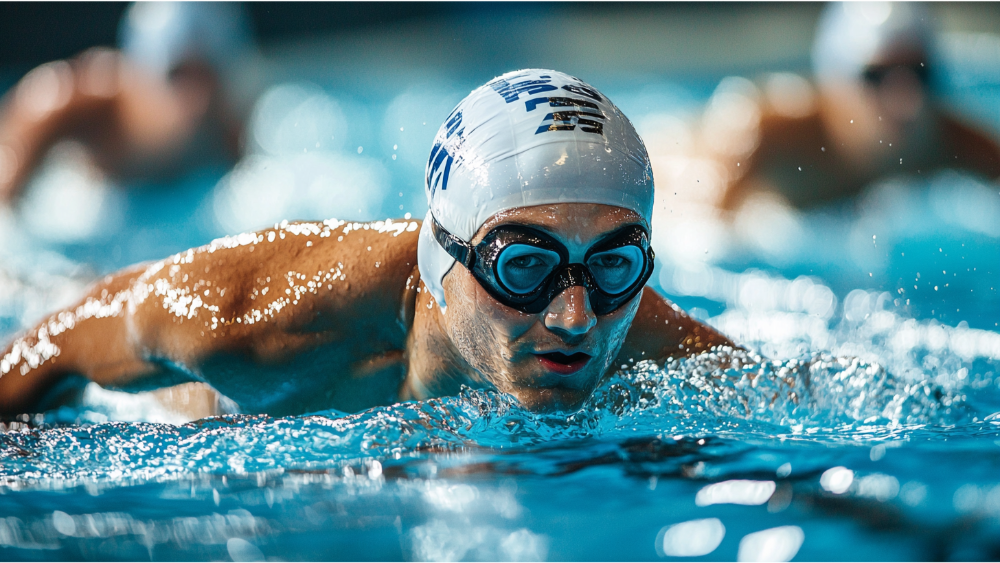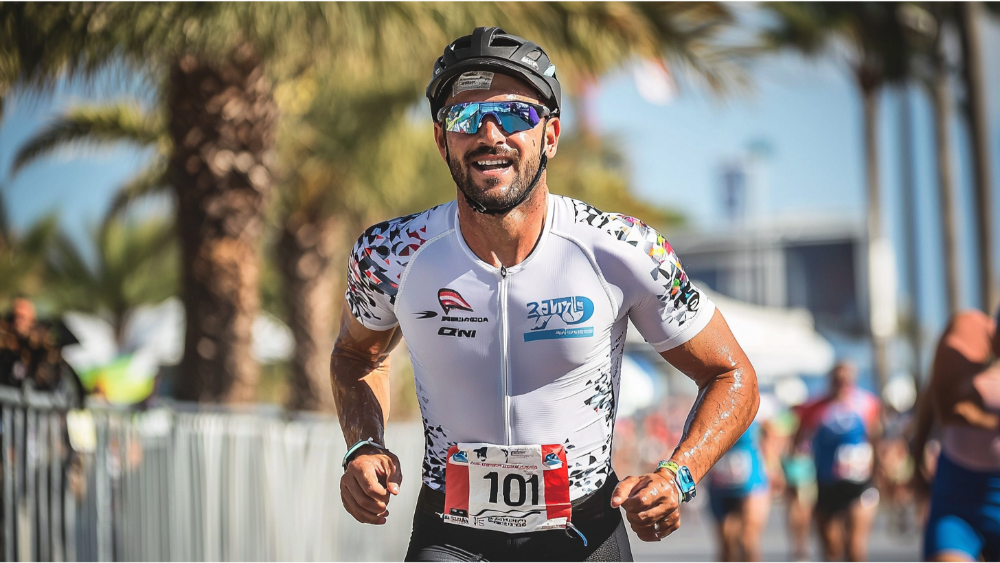Training for an Ironman triathlon is a monumental undertaking that requires dedication, discipline, and a well-structured training plan. Completing an Ironman—comprising a 2.4-mile swim, a 112-mile bike ride, and a 26.2-mile marathon—is a test of both physical and mental endurance. Whether you’re a seasoned athlete or new to triathlons, this guide will break down how to approach your Ironman training and set yourself up for success.
Understanding the Ironman Challenge
What is an Ironman Triathlon?
An Ironman is the ultimate endurance race in the triathlon world, requiring athletes to excel in swimming, cycling, and running, all within one grueling event. The race begins with a 2.4-mile swim, transitions into a 112-mile bike ride, and ends with a full marathon (26.2 miles).
Distance Breakdown (Swim, Bike, Run)
- Swim: 2.4 miles in open water, often posing challenges such as currents and sighting.
- Bike: 112 miles on varying terrain, testing both speed and endurance.
- Run: A marathon distance, demanding not only physical strength but mental resilience to push through fatigue.
Mental and Physical Demands of an Ironman
Training for an Ironman isn’t just about building your physical fitness; it’s about cultivating mental toughness as well. Pacing yourself, staying calm during setbacks, and maintaining motivation through months of training are crucial for success.
The Importance of Mental Resilience
Mental toughness is essential for dealing with the long hours of training and the inevitable fatigue during the race. Visualizing your race day, setting smaller goals, and practicing positive self-talk can help develop mental resilience.
Physical Endurance Requirements
Ironman training builds aerobic capacity, muscular strength, and endurance across three different disciplines. To handle the physical strain of race day, consistent and progressive training is required over several months.
The 4 Phases of Ironman Training

1 | Base Phase (Building Endurance)
The base phase of Ironman training typically lasts 12 to 16 weeks and focuses on building aerobic endurance and basic technique. The goal here is to gradually increase the duration of workouts while keeping the intensity low.
Swim: Technique and Stamina
Swimming efficiently saves energy for the bike and run portions. Focus on proper body position, breathing, and stroke technique to increase speed while minimizing fatigue. Practice in open water to simulate race conditions.
Bike: Aerobic Foundation and Long Rides
In the base phase, prioritize long, steady rides to build your aerobic base. Aim to ride at a comfortable pace for extended periods, gradually increasing the distance as your fitness improves.
Run: Steady, Low-Intensity Runs
Your runs should be steady and controlled, focusing on maintaining a low heart rate (Zone 2) to develop endurance without overexertion. This phase is not about speed but building a strong running foundation.
2 | Build Phase (Increasing Intensity and Strength)
The build phase shifts the focus to higher-intensity workouts and improving strength. Typically lasting 8 to 10 weeks, this phase introduces more race-specific training, including intervals and hill workouts.
Swim: Open Water Practice and Threshold Workouts
Add high-intensity intervals and practice swimming in open water to simulate race day. Threshold workouts—swimming near your lactate threshold—help improve speed and stamina.
Bike: Interval Training and Hill Repeats
Increase the intensity of your bike workouts by incorporating intervals and hill repeats. These sessions build leg strength, improve your ability to handle tough terrain, and boost cardiovascular fitness.
Run: Tempo Runs and Speed Work
Incorporate tempo runs and interval training into your routine to improve your running speed and stamina. These workouts are vital for simulating the effort needed during the final marathon leg of the race.
3 | Peak Phase (Race-Specific Training)

The peak phase occurs in the final 2 to 3 weeks of your training and is designed to simulate race conditions. During this time, you’ll push your body close to race pace while fine-tuning your nutrition and transition strategies.
Combining Disciplines: Brick Workouts
Brick workouts, where you practice cycling followed immediately by running, are essential during the peak phase. These sessions train your body to handle the transition from bike to run, which is one of the toughest aspects of the race.
Simulating Race Conditions
During this phase, your workouts should mimic race day as closely as possible. Complete longer endurance sessions and practice your nutrition and hydration strategies to ensure you’re fully prepared.
4 | Taper Phase (Recovery and Preparation for Race Day)
The taper phase involves reducing the volume of your training while maintaining intensity. This phase allows your body to recover from the months of hard work while keeping your fitness sharp for race day.
Reducing Volume, Maintaining Intensity
Reduce your workout duration by about 50-75%, but keep the intensity high for short bursts. This approach helps you stay sharp without overloading your body before the race.
Mental Focus and Visualization
In the taper phase, mental preparation becomes crucial. Visualize crossing the finish line and practice positive self-talk to build confidence. This mental rehearsal can significantly improve performance on race day.
Key Components of Ironman Training

Swim Training
Mastering the swim is crucial for starting the race strong. Poor swim technique can drain your energy reserves for the bike and run portions.
Technique Over Distance
Focus on perfecting your stroke, body position, and breathing rhythm. Efficiency in the water saves energy, which you’ll need for the rest of the race.
Open Water vs Pool Training
Open water swimming presents challenges like sighting and dealing with waves. Regular open-water sessions help prepare for race day, while pool sessions are great for refining technique.
Bike Training
The bike leg is the longest portion of the Ironman, so it’s vital to build cycling endurance and strength.
Importance of Long Rides
Long rides improve endurance and teach your body how to maintain consistent energy output over extended periods. Plan rides of at least 4-6 hours as you build toward race day.
Building Strength with Threshold Sessions
Incorporate sessions where you ride at or near your lactate threshold to improve speed and power on the bike. These workouts also help you handle sustained efforts on hilly courses.
Run Training
Running is the final and arguably the most challenging leg of the Ironman. Training for the marathon portion is about both physical conditioning and mental strength.
Building Endurance Gradually
Increase your mileage slowly over time, focusing on longer runs at an easy pace to avoid injury. Incorporate rest weeks to allow your body to recover and adapt to the increasing workload.
Injury Prevention in Long-Distance Running
Stay injury-free by incorporating strength training, proper stretching, and foam rolling into your routine. Pay attention to your body and adjust your training load if you notice any signs of overtraining.
Nutrition and Hydration During Training

Daily Nutrition for Endurance Athletes
A well-balanced diet is essential for fueling your body during training. Focus on carbohydrates for energy, proteins for recovery, and fats for sustained endurance.
Balancing Macronutrients
Carbohydrates should make up the bulk of your diet, as they are the primary fuel source for endurance events. Include lean proteins and healthy fats to support muscle recovery and long-term energy needs.
Timing of Meals and Snacks
Eat small, frequent meals to keep your energy levels stable throughout the day. Fuel up before long workouts and recover with a combination of protein and carbs afterward.
Hydration Strategies
Dehydration can lead to poor performance and serious health risks, so it’s important to stay hydrated during training.
Importance of Electrolyte Balance
Replenishing electrolytes is just as important as water intake, especially during long workouts where you sweat more. Sports drinks, electrolyte tablets, and salt supplements can help maintain balance.
Hydration During Long Training Sessions
During long bike rides and runs, drink fluids regularly to prevent dehydration. Aim for about 16-24 ounces of water or sports drink per hour, adjusting based on weather conditions.
Nutrition on Race Day
Race day nutrition is critical for sustaining energy levels throughout the Ironman.
Carbohydrate Loading
In the days leading up to the race, increase your carbohydrate intake to top off glycogen stores. This helps delay fatigue during the race.
Fueling During the Race
Plan to consume energy gels, bars, or sports drinks at regular intervals during the race to maintain energy levels. Practice your nutrition strategy during training to ensure your body tolerates it well.
Recovery and Injury Prevention
Importance of Rest Days
Rest days are essential for allowing your body to recover and repair from the intense training sessions.
Scheduling Rest Periods for Optimal Recovery
Plan at least one full rest day per week, and incorporate lighter recovery weeks into your schedule every three to four weeks. This approach helps prevent burnout and injury.
Active vs Passive Recovery
Active recovery, such as light swimming or yoga, can promote blood flow and reduce muscle soreness. Passive recovery, such as massage or foam rolling, helps release tension and aid muscle repair.
Managing and Preventing Injuries
Injuries can derail your Ironman training, so it’s crucial to take steps to prevent them.
Common Injuries During Ironman Training
Runners’ knee, Achilles tendonitis, and shoulder pain from swimming are common issues. Address these by focusing on proper form, stretching, and strength training.
Tips for Injury Prevention
Incorporate strength training, dynamic stretching, and foam rolling into your routine to stay limber and strong. Listen to your body, and don’t push through pain.
The Role of Sleep and Recovery Tools
Adequate sleep is one of the most powerful recovery tools at your disposal.
How Sleep Impacts Performance
Aim for 7-9 hours of sleep each night to allow your musclesto recover and adapt to the demands of training. Insufficient sleep can impair muscle recovery and lead to diminished performance. Aim for 7-9 hours per night, especially after intense sessions.
Using Foam Rolling, Stretching, and Massage
Incorporating foam rolling and massage into your routine helps release muscle tension and aids in faster recovery. Dynamic stretching before workouts and static stretching afterward will keep your muscles flexible and less prone to injury.
Race Day Strategies

Pacing and Energy Management
On race day, managing your pace is essential to finishing strong. Going too hard early in the race, especially during the bike portion, can lead to early fatigue, making the marathon significantly harder.
Swim: Starting Steady and Controlled
Start your swim at a steady, controlled pace to conserve energy. Avoid going all out in the first few minutes, as the swim is only the first part of a long day.
Bike: Pacing for a Strong Run
The bike portion is where many athletes burn out if they don’t pace themselves properly. Keep a sustainable pace, saving energy for the run. This is a race of endurance, not just speed.
Run: Managing Fatigue and Finishing Strong
By the time you reach the run, fatigue will likely set in. Focus on managing your energy levels, using a run/walk strategy if needed, to complete the marathon without hitting the wall.
Transition Mastery
Transitions can make or break your race time, so it’s important to practice them in training and execute them efficiently on race day.
Minimizing Transition Time
Have your gear organized and know exactly where everything is during transitions. Quick gear changes can save valuable minutes.
Efficient Gear Changes
Practice getting out of your wetsuit and into your cycling gear quickly. Similarly, ensure your bike-to-run transition is smooth by keeping your running shoes and gear readily accessible.
Mental Toughness and Focus

Building Mental Resilience
Enduring an Ironman requires a high degree of mental toughness. Training your mind is just as important as training your body.
Visualization Techniques
Visualize the race day in your mind. Picture yourself overcoming challenges, from swimming through choppy waters to finishing the marathon strong. Visualization helps prepare you mentally for the race ahead.
Breaking the Race into Manageable Segments
Mentally divide the race into smaller sections. Focus on completing the swim, then the bike, and finally the run. Breaking it down prevents you from feeling overwhelmed by the enormity of the task.
Dealing with Setbacks During Training
Setbacks are inevitable, whether they come in the form of missed sessions, injuries, or motivation dips. Dealing with these challenges effectively ensures they don’t derail your training.
Overcoming Mental Fatigue
In long training blocks, mental fatigue is common. Incorporate variety in your workouts and take mental breaks when needed to stay fresh.
Staying Motivated Throughout Long Training Cycles
Find ways to stay motivated by setting smaller goals, such as completing a half-Ironman or improving your swim times. Celebrate each accomplishment to keep your momentum going.
Conclusion
The Journey to Becoming an Ironman
Training for an Ironman is more than just preparing for a race—it’s a journey of endurance, mental fortitude, and personal growth. By following a structured plan, focusing on nutrition and recovery, and developing mental resilience, you’ll be fully prepared to conquer the challenge of an Ironman.
Embracing the Training Process
Enjoy the process, celebrate your progress, and remember that the journey is just as important as race day. The discipline and dedication you develop will not only carry you through the Ironman but also in other areas of life.
Celebrating the Achievement
Crossing the finish line of an Ironman is a life-changing achievement. It’s the culmination of months of hard work, sacrifice, and determination. Relish the moment and know that you’ve earned the title of Ironman.

Leave a Reply